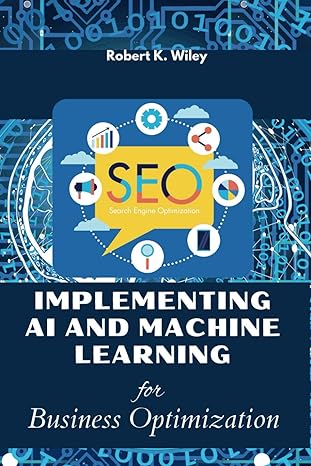Answered step by step
Verified Expert Solution
Question
1 Approved Answer
i have 30 mins to finish please help Item 1 In the case below, the original source material is given along with a sample of
i have 30 mins to finish please help
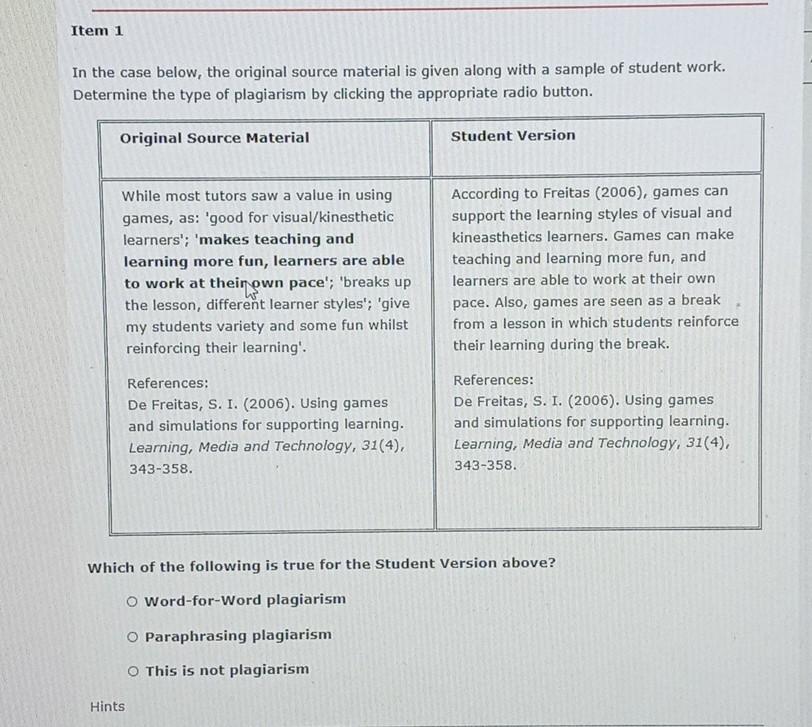
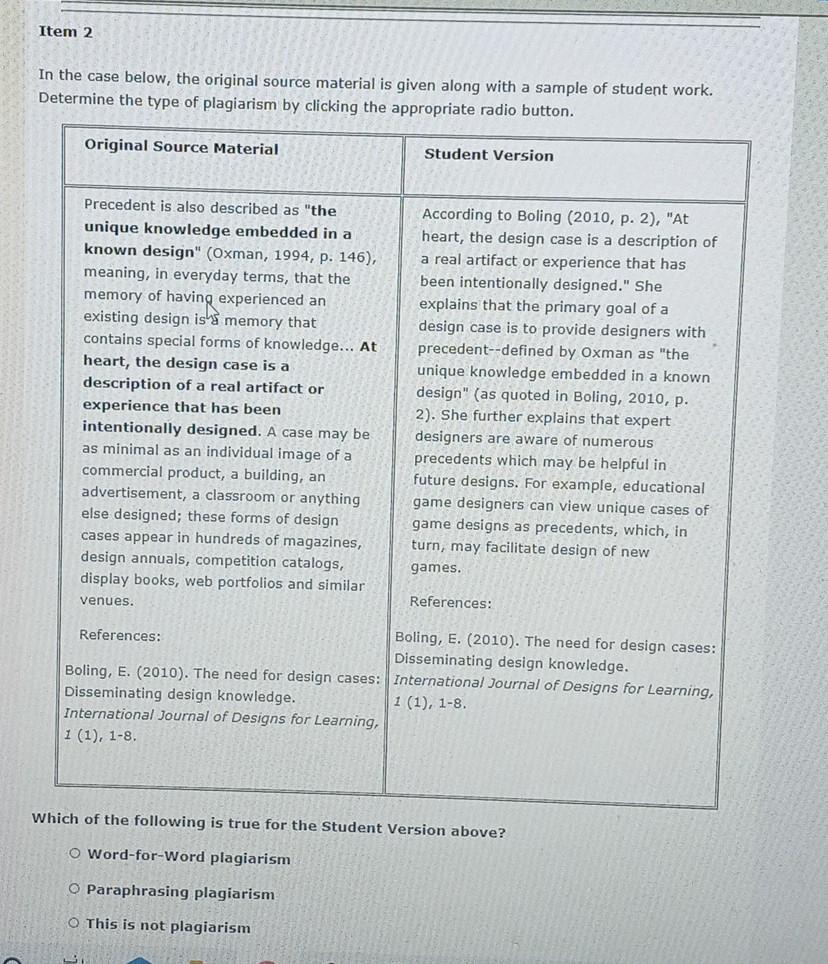
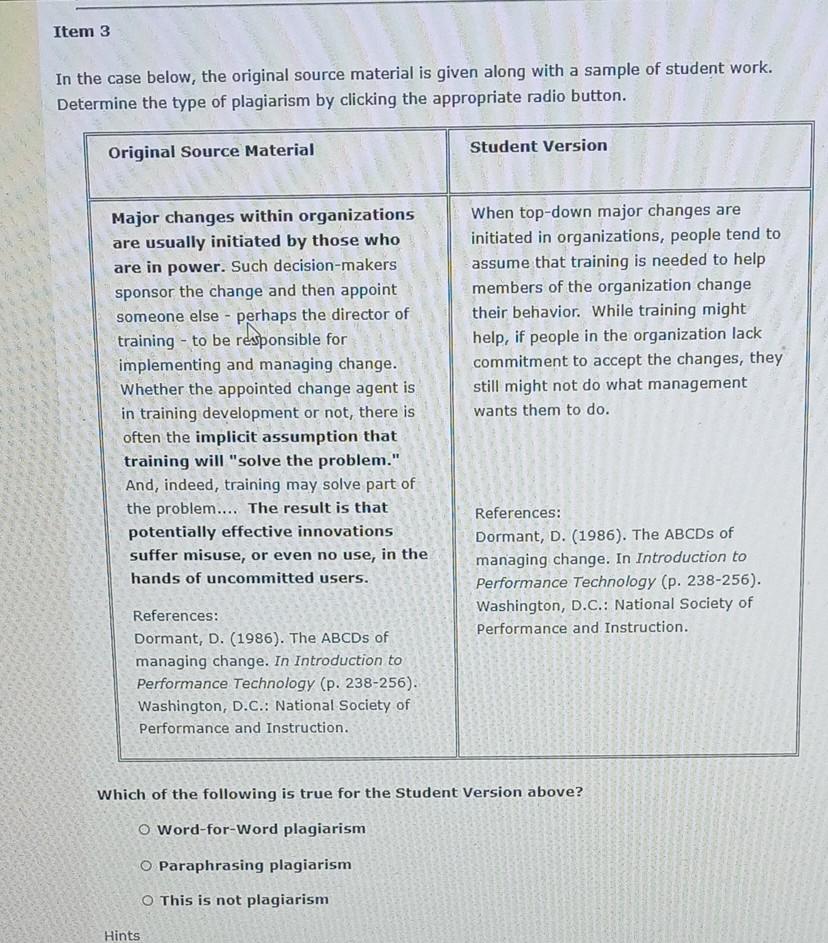
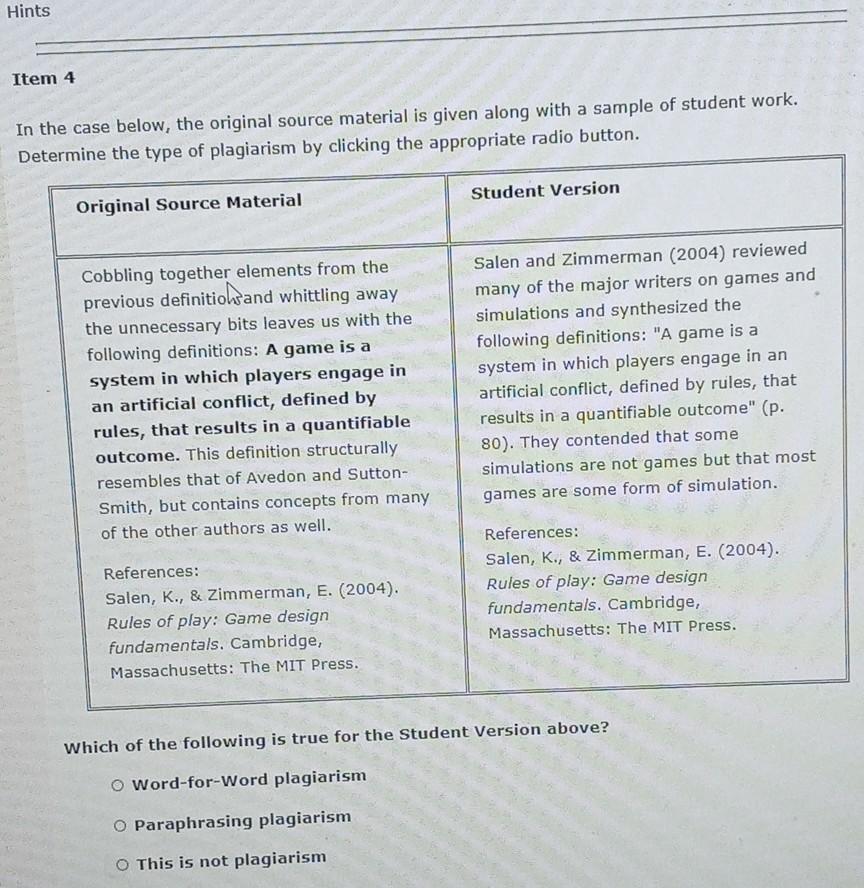
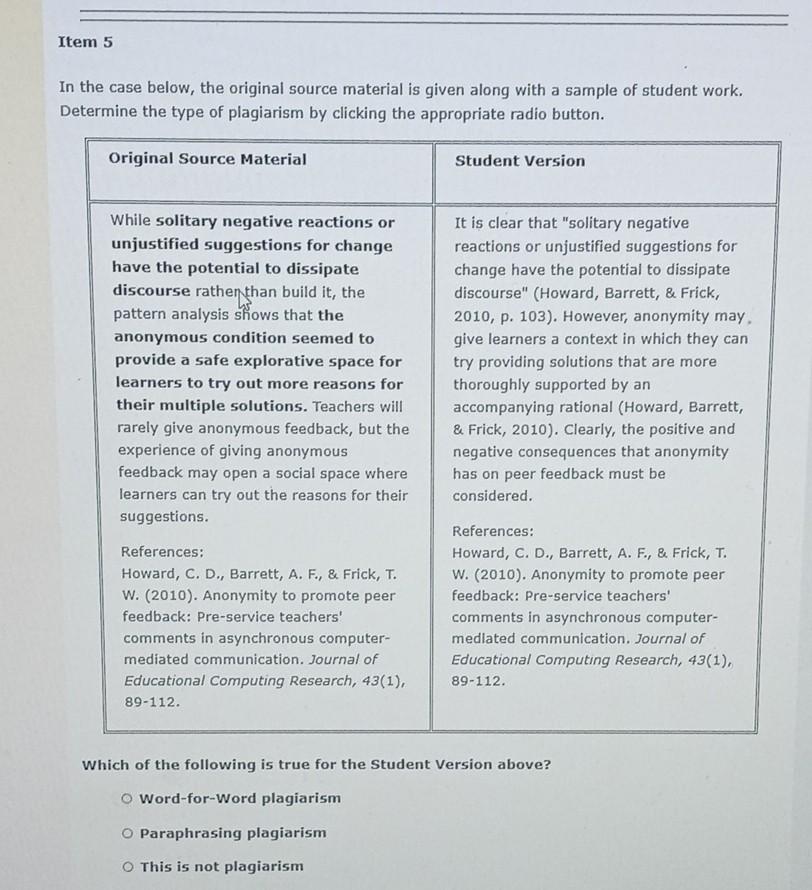
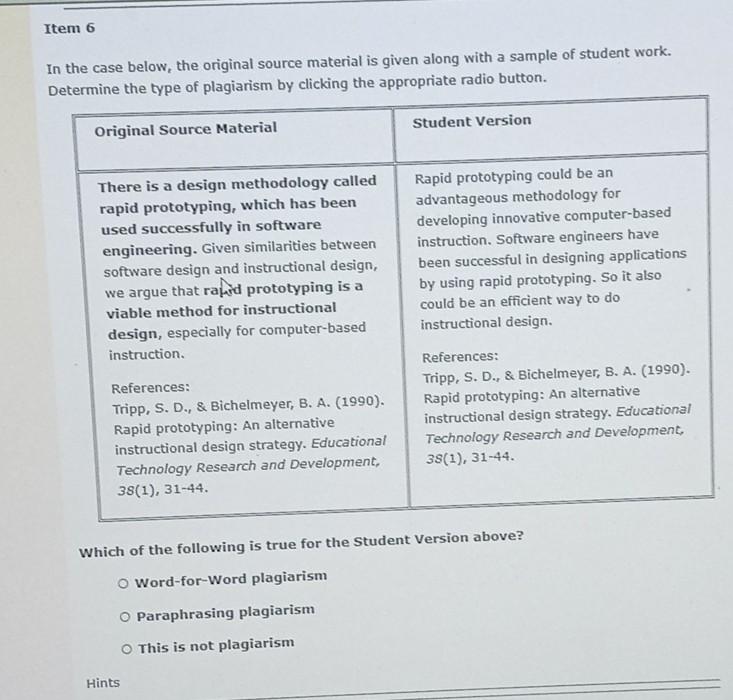
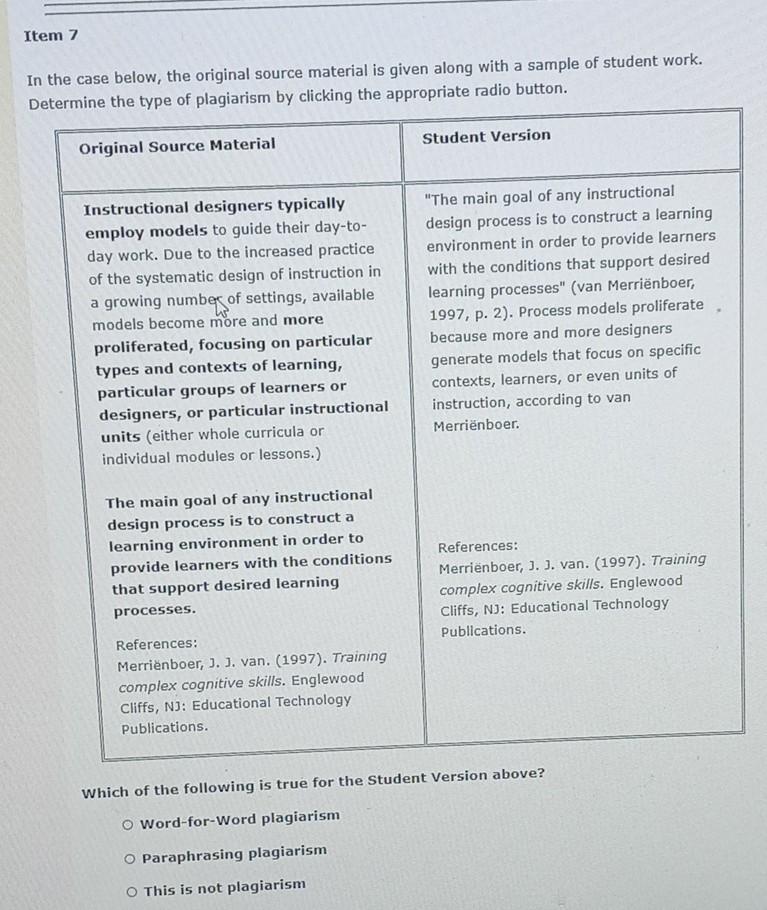
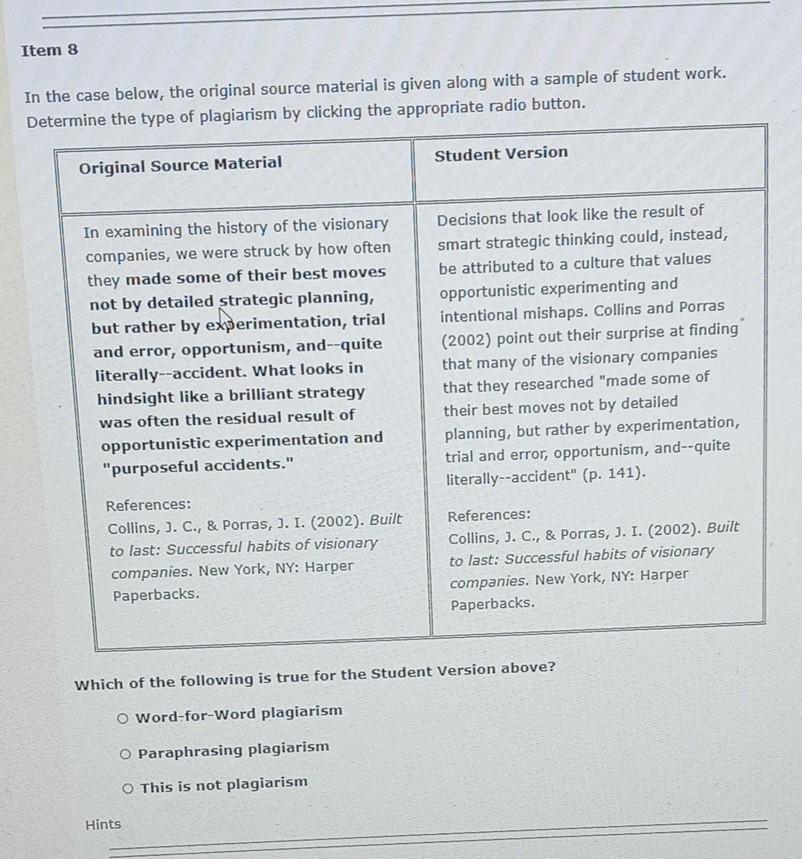
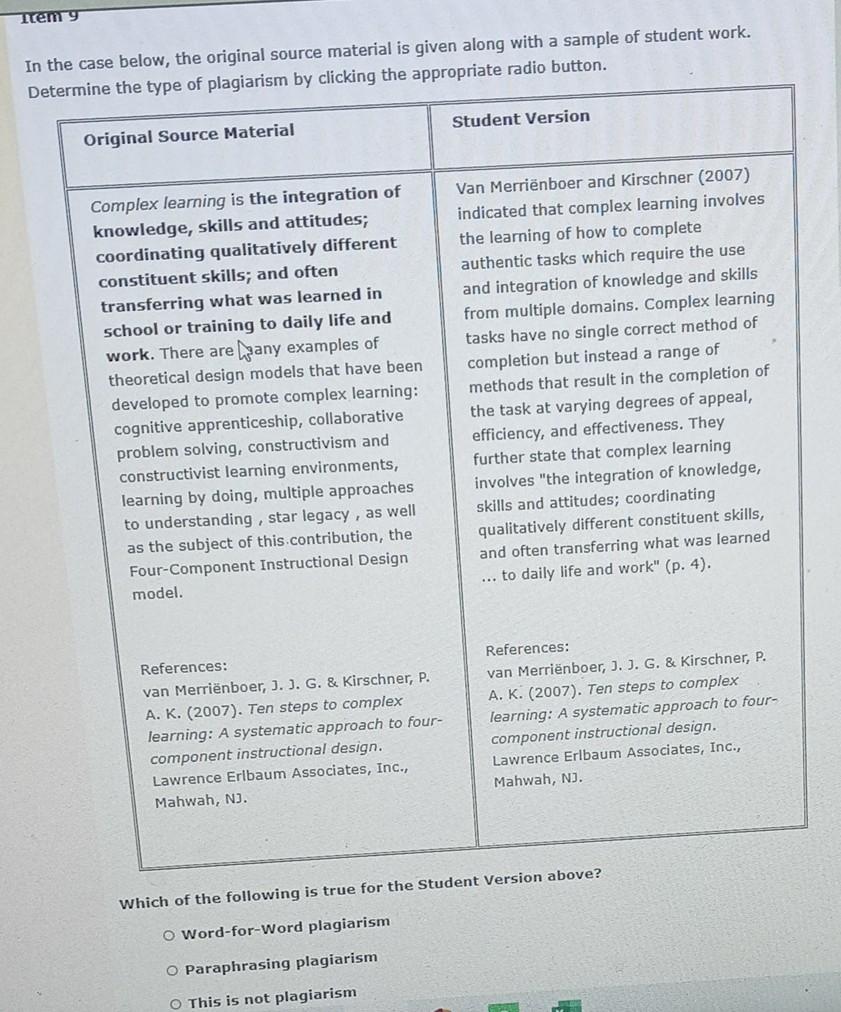
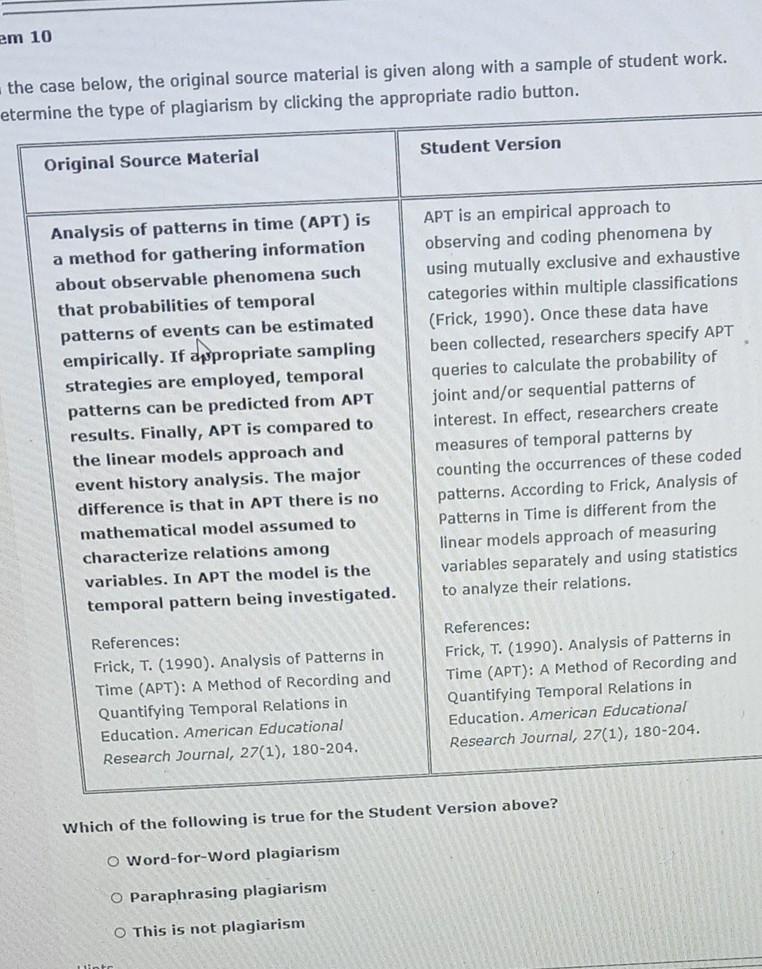
Item 1 In the case below, the original source material is given along with a sample of student work. Determine the type of plagiarism by clicking the appropriate radio button. Original Source Material Student Version While most tutors saw a value in using games, as: 'good for visual/kinesthetic learners'; 'makes teaching and learning more fun, learners are able to work at theingwn pace'; 'breaks up the lesson, different learner styles'; 'give my students variety and some fun whilst reinforcing their learning'. According to Freitas (2006), games can support the learning styles of visual and kineasthetics learners. Games can make teaching and learning more fun, and learners are able to work at their own pace. Also, games are seen as a break from a lesson in which students reinforce their learning during the break. References: De Freitas, S. I. (2006). Using games and simulations for supporting learning. Learning, Media and Technology, 31(4), 343-358. References: De Freitas, S. I. (2006). Using games and simulations for supporting learning. Learning, Media and Technology, 31(4), 343-358. Which of the following is true for the Student Version above? O Word-for-Word plagiarism O Paraphrasing plagiarism O This is not plagiarism Hints Item 2 In the case below, the original source material is given along with a sample of student work. Determine the type of plagiarism by clicking the appropriate radio button. Original Source Material Student Version Precedent is also described as "the unique knowledge embedded in a known design" (Oxman, 1994, p. 146), meaning, in everyday terms, that the memory of having experienced an existing design is memory that contains special forms of knowledge... At heart, the design case is a description of a real artifact or experience that has been intentionally designed. A case may be as minimal as an individual image of a commercial product, a building, an advertisement, a classroom or anything else designed; these forms of design cases appear in hundreds of magazines, design annuals, competition catalogs, display books, web portfolios and similar According to Boling (2010, p. 2), "At heart, the design case is a description of a real artifact or experience that has been intentionally designed." She explains that the primary goal of a design case is to provide designers with precedent--defined by Oxman as "the unique knowledge embedded in a known design" (as quoted in Boling, 2010, p. 2). She further explains that expert designers are aware of numerous precedents which may be helpful in future designs. For example, educational game designers can view unique cases of game designs as precedents, which, in turn, may facilitate design of new games. venues. References: References: Boling, E. (2010). The need for design cases: Disseminating design knowledge. Boling, E. (2010). The need for design cases: International Journal of Designs for Learning, Disseminating design knowledge. 1 (1), 1-8. International Journal of Designs for Learning, 1 (1), 1-8. Which of the following is true for the Student Version above? O Word-for-Word plagiarism O Paraphrasing plagiarism O This is not plagiarism Item 3 In the case below, the original source material is given along with a sample of student work. Determine the type of plagiarism by clicking the appropriate radio button. Original Source Material Student Version Major changes within organizations are usually initiated by those who are in power. Such decision-makers sponsor the change and then appoint someone else - perhaps the director of training - to be responsible for implementing and managing change. Whether the appointed change agent is in training development or not, there is oft the implicit assumption that training will "solve the problem." And, indeed, training may solve part of the problem.... The result is that potentially effective innovations suffer misuse, or even no use, in the hands of uncommitted users. When top-down major changes are initiated in organizations, people tend to assume that training is needed to help members of the organization change their behavior. While training might help, if people in the organization lack commitment to accept the changes, they still might not do what management wants them to do. References: Dormant, D. (1986). The ABCDs of managing change. In Introduction to Performance Technology (p. 238-256). Washington, D.C.: National Society of Performance and Instruction. References: Dormant, D. (1986). The ABCDs of managing change. In Introduction to Performance Technology (p. 238-256). Washington, D.C.: National Society of Performance and Instruction. Which of the following is true for the Student Version above? O Word-for-Word plagiarism O Paraphrasing plagiarism O This is not plagiarism Hints Hints Item 4 In the case below, the original source material is given along with a sample of student work. Determine the type of plagiarism by clicking the appropriate radio button. Student Version Original Source Material Cobbling together elements from the previous definitiohsand whittling away the unnecessary bits leaves us with the following definitions: A game is a system in which players engage in an artificial conflict, defined by rules, that results in a quantifiable outcome. This definition structurally resembles that of Avedon and Sutton- Smith, but contains concepts from many of the other authors as well. Salen and Zimmerman (2004) reviewed many of the major writers on games and simulations and synthesized the following definitions: "A game is a system in which players engage in an artificial conflict, defined by rules, that results in a quantifiable outcome" (p. 80). They contended that some simulations are not games but that most games are some form of simulation. References: Salen, K., & Zimmerman, E. (2004). Rules of play: Game design fundamentals. Cambridge, Massachusetts: The MIT Press. References: Salen, K., & Zimmerman, E. (2004). Rules of play: Game design fundamentals. Cambridge, Massachusetts: The MIT Press. Which of the following is true for the Student Version above? o Word-for-Word plagiarism O Paraphrasing plagiarism O This is not plagiarism Item 5 In the case below, the original source material is given along with a sample of student work. Determine the type of plagiarism by clicking the appropriate radio button. Original Source Material Student Version While solitary negative reactions or unjustified suggestions for change have the potential to dissipate discourse rather than build it, the pattern analysis shows that the anonymous condition seemed to provide a safe explorative space for learners to try out more reasons for their multiple solutions. Teachers will rarely give anonymous feedback, but the experience of giving anonymous feedback may open a social space where learners can try out the reasons for their suggestions. It is clear that "solitary negative reactions or unjustified suggestions for change have the potential to dissipate discourse" (Howard, Barrett, & Frick, 2010, p. 103). However, anonymity may. give learners a context in which they can try providing solutions that are more thoroughly supported by an accompanying rational (Howard, Barrett, & Frick, 2010). Clearly, the positive and negative consequences that anonymity has on peer feedback must be considered. References: Howard, C. D., Barrett, A. F., & Frick, T. W. (2010). Anonymity to promote peer feedback: Pre-service teachers' comments in asynchronous computer- mediated communication. Journal of Educational Computing Research, 43(1), 89-112. References: Howard, C. D., Barrett, A. F., & Frick, T. W. (2010). Anonymity to promote peer feedback: Pre-service teachers' comments in asynchronous computer- mediated communication. Journal of Educational Computing Research, 43(1), 89-112. Which of the following is true for the Student Version above? o Word-for-Word plagiarism O Paraphrasing plagiarism O This is not plagiarism Item 6 In the case below, the original source material is given along with a sample of student work. Determine the type of plagiarism by clicking the appropriate radio button. Student Version Original Source Material There is a design methodology called rapid prototyping, which has been used successfully in software engineering. Given similarities between software design and instructional design, we argue that rapid prototyping is a viable method for instructional design, especially for computer-based instruction. Rapid prototyping could be an advantageous methodology for developing innovative computer-based instruction. Software engineers have been successful in designing applications by using rapid prototyping. So it also could be an efficient way to do instructional design. References: Tripp, S. D., & Bichelmeyer, B. A. (1990). Rapid prototyping: An alternative instructional design strategy. Educational Technology Research and Development, 38(1), 31-44. References: Tripp, S. D., & Bichelmeyer, B. A. (1990). Rapid prototyping: An alternative instructional design strategy. Educational Technology Research and Development, 38(1), 31-44. Which of the following is true for the Student Version above? O Word-for-Word plagiarism O Paraphrasing plagiarism This is not plagiarism Hints Item 7 In the case below, the original source material is given along with a sample of student work. Determine the type of plagiarism by clicking the appropriate radio button. Student Version Original Source Material Instructional designers typically employ models to guide their day-to- day work. Due to the increased practice of the systematic design of instruction in a growing number of settings, available models become more and more proliferated, focusing on particular types and contexts of learning, particular groups of learners or designers, or particular instructional units (either whole curricula or individual modules or lessons.) "The main goal of any instructional design process is to construct a learning environment in order to provide learners with the conditions that support desired learning processes" (van Merrinboer, 1997, p. 2). Process models proliferate because more and more designers generate models that focus on specific contexts, learners, or even units of instruction, according to van Merrienboer. The main goal of any instructional design process is to construct a learning environment in order to provide learners with the conditions that support desired learning processes. References: Merrienboer, J. J. van. (1997). Training complex cognitive skills. Englewood Cliffs, NJ: Educational Technology Publications. References: Merrienboer, J. J. van. (1997). Training complex cognitive skills. Englewood Cliffs, NJ: Educational Technology Publications. Which of the following is true for the Student Version above? o Word-for-Word plagiarism O Paraphrasing plagiarism This is not plagiarism Item 8 In the case below, the original source material is given along with a sample of student work. Determine the type of plagiarism by clicking the appropriate radio button. Student Version Original Source Material In examining the history of the visionary companies, we were struck by how often they made some of their best moves not by detailed strategic planning, but rather by experimentation, trial and error, opportunism, and --quite literally--accident. What looks in hindsight like a brilliant strategy was often the residual result of opportunistic experimentation and "purposeful accidents." Decisions that look like the result of smart strategic thinking could, instead, be attributed to a culture that values opportunistic experimenting and intentional mishaps. Collins and Porras (2002) point out their surprise at finding that many of the visionary companies that they researched "made some of their best moves not by detailed planning, but rather by experimentation, trial and error, opportunism, and-- quite literally--accident" (p. 141). References: Collins, J. C., & Porras, J. I. (2002). Built to last: Successful habits of visionary companies. New York, NY: Harper Paperbacks. References: Collins, J. C., & Porras, J. I. (2002). Built to last: Successful habits of visionary companies. New York, NY: Harper Paperbacks. Which of the following is true for the Student Version above? O Word-for-Word plagiarism O Paraphrasing plagiarism This is not plagiarism Hints Tema In the case below, the original source material is given along with a sample of student work. Determine the type of plagiarism by clicking the appropriate radio button. Student Version Original Source Material Complex learning is the integration of knowledge, skills and attitudes; coordinating qualitatively different constituent skills; and often transferring what was learned in school or training to daily life and work. There are any examples of theoretical design models that have been developed to promote complex learning: cognitive apprenticeship, collaborative problem solving, constructivism and constructivist learning environments, learning by doing, multiple approaches to understanding, star legacy, as well as the subject of this contribution, the Four-Component Instructional Design model. Van Merrinboer and Kirschner (2007) indicated that complex learning involves the learning of how to complete authentic tasks which require the use and integration of knowledge and skills from multiple domains. Complex learning tasks have no single correct method of completion but instead a range of methods that result in the completion of the task at varying degrees of appeal, efficiency, and effectiveness. They further state that complex learning involves "the integration of knowledge, skills and attitudes; coordinating qualitatively different constituent skills, and often transferring what was learned ... to daily life and work" (p. 4). References: van Merrinboer, J. J. G. & Kirschner, P. A. K. (2007). Ten steps to complex learning: A systematic approach to four- component instructional design. Lawrence Erlbaum Associates, Inc., Mahwah, NJ. References: van Merrinboer, J. J. G. & Kirschner, P. A. K. (2007). Ten steps to complex learning: A systematic approach to four- component instructional design. Lawrence Erlbaum Associates, Inc., Mahwah, NJ. Which of the following is true for the Student Version above? o Word-for-Word plagiarism O Paraphrasing plagiarism O This is not plagiarism em 10 the case below, the original source material is given along with a sample of student work. etermine the type of plagiarism by clicking the appropriate radio button. Student Version Original Source Material Analysis of patterns in time (APT) is a method for gathering information about observable phenomena such that probabilities of temporal patterns of events can be estimated empirically. If appropriate sampling strategies are employed, temporal patterns can be predicted from APT results. Finally, APT is compared to the linear models approach and event history analysis. The major difference is that in APT there is no mathematical model assumed to characterize relations among variables. In APT the model is the temporal pattern being investigated. APT is an empirical approach to observing and coding phenomena by using mutually exclusive and exhaustive categories within multiple classifications (Frick, 1990). Once these data have been collected, researchers specify APT queries to calculate the probability of joint and/or sequential patterns of interest. In effect, researchers create measures of temporal patterns by counting the occurrences of these coded patterns. According to Frick, Analysis of Patterns in Time is different from the linear models approach of measuring variables separately and using statistics to analyze their relations. References: Frick, T. (1990). Analysis of Patterns in Time (APT): A Method of Recording and Quantifying Temporal Relations in Education. American Educational Research Journal, 27(1), 180-204. References: Frick, T. (1990). Analysis of Patterns in Time (APT): A Method of Recording and Quantifying Temporal Relations in Education. American Educational Research Journal, 27(1), 180-204. Which of the following is true for the Student Version above? O Word-for-Word plagiarism O Paraphrasing plagiarism This is not plagiarism
Step by Step Solution
There are 3 Steps involved in it
Step: 1

Get Instant Access to Expert-Tailored Solutions
See step-by-step solutions with expert insights and AI powered tools for academic success
Step: 2

Step: 3

Ace Your Homework with AI
Get the answers you need in no time with our AI-driven, step-by-step assistance
Get Started


